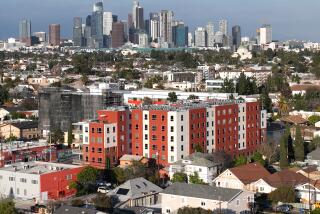Curbing Growth in Los Angeles
- Share via
I read with growing fear about the city’s budget woes, the $33-million Los Angeles Unified School District deficit and now the dismal, 10-year record of the City Planning Department (“Politics Mires City Planners, Audit Says,” front page, Aug. 7).
As an urban planner, my mission for the last 20 years has been, and continues to be, the limitation of world population growth, which is crucial to the survival of planet Earth. Now that focus has switched to Southern California, Los Angeles in particular, which now has many similarities with Third World cities. Rampant population growth here, caused by both legal and illegal immigration and rapid natural increase, is the root cause of many of our Southern California problems: quality of life, economic decline, homelessness, increasing poverty and crime and air-quality deterioration. Population growth, highest among Latinos and first-generation Asians, is a controllable element: family planning, free voluntary sterilization programs, education, crackdown of illegal immigration and other inexpensive tactics.
Growth management of population and slow-growth development go hand-in-hand. Little attention has been paid to either issue by our county supervisors, mayor or city councilmen because it is a “hot potato” issue. But their neglect has caused California to slip to second-rate status financially, environmentally and quality of life-wise. Industries are moving out. School problems are appalling. Crime and gang warfare have doubled. Homelessness increases. The number of pregnant teen-agers, crack babies, abused children have tripled.
Yet with another 10 million people projected for California, no public official seems outraged and fearful at this number with whom we have to share our meager water supply, our overburdened streets and freeways, our dwindling dollar for services and health care. What are our politicians doing about it? Nothing!
It is about time to start. The easiest solution is to advocate small families, and teach teen-agers not to have babies until they are married or in their 20s.
The other solution is for the City Council to revamp and redirect its Planning Department, making it an independent body, not beholden to councilmen’s pet projects. Slow growth, managed growth, downzoning, clustering, aesthetic and poverty-solving growth are intrinsic to good planning. City Council, Mayor Bradley and supervisors, start now.
MARILYN BRANT STUART
President, Southern California
Population Crisis Committee, Los Angeles
More to Read
Sign up for Essential California
The most important California stories and recommendations in your inbox every morning.
You may occasionally receive promotional content from the Los Angeles Times.













